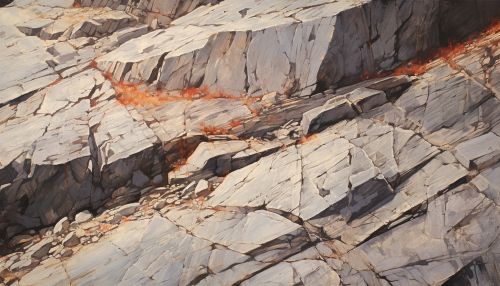Weathering
Introduction
Weathering is the process that alters the physical and chemical characteristics of rocks and minerals at or near the Earth's surface. This process is driven by atmospheric conditions, including water, temperature fluctuations, and biological activity. Weathering is a fundamental process in the rock cycle, contributing to the formation of soil and shaping the Earth's topography.
Types of Weathering
There are two primary types of weathering: physical (or mechanical) weathering and chemical weathering.
Physical Weathering
Physical weathering involves the breakdown of rocks and minerals into smaller pieces without changing their chemical composition. This type of weathering is often driven by temperature fluctuations, which can cause rocks to expand and contract, leading to fracturing.


Other processes involved in physical weathering include freeze-thaw cycles, where water seeps into cracks in the rock, freezes, expands, and causes the rock to break apart. This is a common process in colder climates.
Chemical Weathering
Chemical weathering involves the alteration of the rock's original minerals into new minerals. This process is often facilitated by water, which can dissolve certain minerals, and by the presence of gases in the atmosphere, such as carbon dioxide and oxygen.
One of the most common types of chemical weathering is the process of oxidation, where iron-rich minerals react with oxygen to form rust-like compounds. Another common type is hydrolysis, where water molecules react with minerals to form new minerals and soluble salts.
Factors Influencing Weathering
Several factors influence the rate and extent of weathering, including the rock's mineral composition, climate, topography, and biological activity.
Rock Composition and Structure
The mineral composition and structure of a rock can greatly influence its susceptibility to weathering. For instance, rocks composed of minerals that are resistant to chemical reactions, such as quartz, are less likely to undergo chemical weathering. Similarly, rocks with a highly fractured structure are more susceptible to physical weathering.
Climate
The climate plays a significant role in weathering. In general, weathering is more intense in areas with high temperatures and high rainfall. This is because heat facilitates chemical reactions, and water is a key agent of both physical and chemical weathering.
Topography
The physical layout of the land, or topography, also influences weathering. Slopes and cliffs are more prone to physical weathering due to the impact of gravity. Water runoff on slopes can also enhance both physical and chemical weathering.
Biological Activity
Organisms, from bacteria to plants and animals, can contribute to weathering. For instance, plant roots can grow into cracks in rocks, causing them to break apart. Certain bacteria and fungi can also produce acids that facilitate chemical weathering.
Impacts of Weathering
Weathering has significant impacts on various aspects of the Earth's system.
Soil Formation
Weathering is a key process in the formation of soil. The breakdown of rocks and minerals provides the inorganic component of soil, which, combined with organic matter, forms fertile soil that supports plant growth.
Landform Development
Weathering also contributes to the development of landforms. For instance, the weathering of mountain ranges leads to the formation of hills and valleys. Similarly, the weathering of rocks on the coastline contributes to the formation of beaches and cliffs.
Nutrient Cycling
Weathering plays a crucial role in the Earth's nutrient cycles. The breakdown of rocks releases essential nutrients, such as calcium, potassium, and phosphorus, which are then taken up by plants and enter the food chain.
